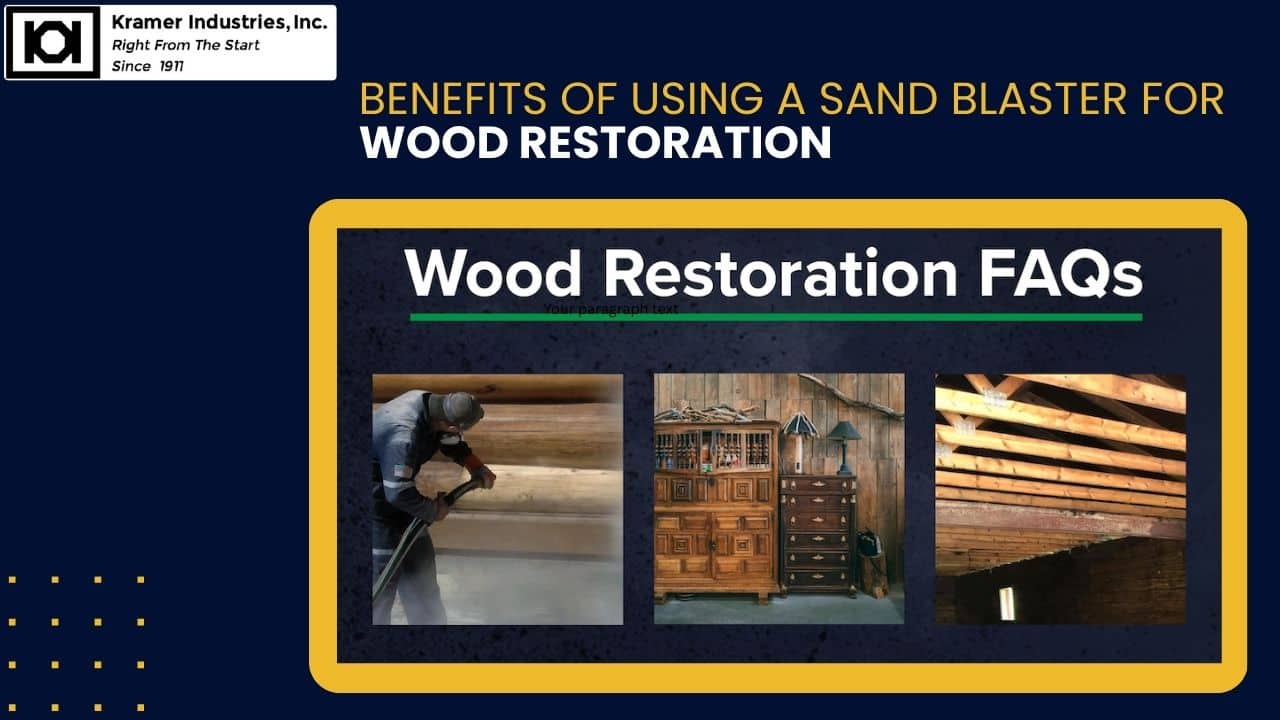Wood with its dent, coats of paint, and layers of varnish tells you about its journey. But sometimes, you want to bring it back to its original glory. You want to peel the layers that are now hiding the natural beauty underneath. That is where a sand blaster for wood steps in. This tool is a texture-maker and a restorer of forgotten grains of wood. Last but not least, it is a time-saver. Unlike hand sanding, which is laborious, blasting reaches corners your fingers never will, and it does the job in minutes.
This guide takes you through the wonderful benefits of blasting wood, why the right machine matters, and how to get the best results.
Why Use a Sand Blaster for Wood Restoration?
Wood is soft and delicate. Over the years, it hides beneath grime, paint, varnish, or mold. Scraping it all away by hand can drain hours, even days. But a sand blaster for wood helps you skip that struggle. With the force of compressed air and a gentle abrasive, it wipes the surface clean without harming the grain. Old coatings vanish. What remains is a raw surface ready for refinishing. Achieve finishes from rustic charm to silky smooth with just an adjustment of the pressure and media.
Key Benefits of Using a Sand Blaster for Wood
1. Efficiency and Time Savings
Manual sanding needs patience, as it is painfully slow. Furniture with curves, beams with grooves, and designs with impossible edges take a lot of manual effort, but blasting can do it fast. A sand blaster for wood eats away coatings evenly and swiftly. Be it large surfaces or tiny carvings, it makes little difference.
2. Gentle Yet Effective Cleaning
Strangely enough, blasting isn’t as harsh as it sounds. When done with walnut shells, corncob grit, or glass beads, it becomes surprisingly gentle. These abrasives strip paint and grime without slicing into the fibers of wood. The wood’s character remains untouched, preserved, and even celebrated.
3. Restores Natural Beauty
Layers of varnish and dust hide the surface of your piece of furniture. A sand blaster for wood peels back those layers in minutes. Suddenly, the grain appears, bold and visible. You can stain, seal, or oil it as you deem fit. This is why antique restorers swear by blasting. It brings out the true nature of the wood and gives it a second life.
4. Creates Custom Textures
Blasting isn’t just about cleaning. With tweaks to pressure, nozzle distance, and abrasive choice, you can sculpt textures. You can have a variety of finishes from smooth elegance to rustic weathering and dramatic contrast. A sand blaster for wood doesn’t just restore, it helps you to transform it.
5. Eco-Friendly Restoration
Chemicals strip. They also stink, pollute, and linger. Blasting with walnut shells or corncob grit, however, is kind to the environment. These natural abrasives are biodegradable and safe for use indoors or outdoors. Without harsh fumes and toxic disposal, you get clean surfaces and a clean conscience.
Choosing the Right Sand Blaster for Wood
Types of Blasters
Not every project calls for the same tool. Siphon-feed sandblasters are steady and precise—perfect for delicate restoration. Pressure-feed models, on the other hand, come with strength, moving through thick paint layers but requiring care. Gravity-feed blasters are small, nimble, and excellent for detail work. For most woodworkers, siphon or gravity-feed options balance control and power beautifully.
Picking the Right Media
Choosing the right blaster is only half the story. The abrasive matters just as much. Walnut shells are gentle, biodegradable, and perfect for painted furniture. Corncob grit is great at lifting dirt and oil from old beams. Glass beads are ideal for smooth, matte finishes. Always test your choice on a hidden spot first. Each piece of wood is unique, and it may surprise you.
Air Pressure and Nozzle Control
Pressure decides everything. Too high, and you could have made deep scars. Too low, and the finish feels incomplete. A sand blaster for wood usually works best at 30–50 PSI. Pair that with a small nozzle, and you gain accuracy. Precision matters most when dealing with fragile antiques or carved details.
Safety Considerations
Blasting is exciting, but dust is not. Even natural abrasives turn into clouds that irritate lungs and eyes. Before pulling the trigger of your blaster, it is necessary to gear up. Use a respirator or a dust mask, goggles or a blasting helmet, gloves, and sturdy clothing. If indoors, ensure good ventilation in the area or use dust collectors. Protect yourself as carefully as you protect the wood.
Portability and Flexibility
Some sandblasters are heavy and stationary. Others are small, portable, and you can move them between projects. Woodworkers prefer tools with mobility. Tools such as the compact siphon or gravity-feed blaster will give you the freedom to tackle beams, panels, or furniture without limits. Remember to match your blaster not just to the project but also to your workspace and habits.
Conclusion
A sand blaster for wood is a machine that helps you to be creative. It protects delicate fibers and uncovers the natural beauty of wood with surprising ease. Most importantly, it saves quite some time. It creates textures impossible to achieve with hand sanding or chemicals. And it does so in a manner that is safe for you and the environment.
The bottom line is to choose wisely. The right tool, the right abrasive, and the right settings will give you what you want to achieve in wood restoration. With a little practice, you can return the shine to tired, lifeless wood surfaces.
At Kramer Industries, wood restoration gets done with precision. From powerful blasting equipment to natural abrasives like walnut shells and corncob grit, you get the right solutions for every project. Kramer has the gear and the know-how for every finish on wood. Contact Kramer Industries today and discover how the right sand blaster for wood can transform your projects into timeless pieces.



